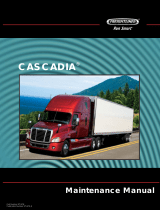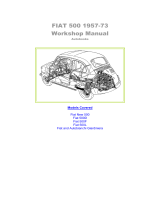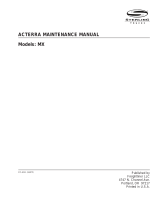Page is loading ...

1
®
SD-03-3602
Bendix
®
TW-1
™
, TW-3
™
, TW-4
™
, TW-5
™
& TW-6
™
Control Valves
FIGURE 1 TW-1
™
CONTROL VALVE
1/8” P.T.
SUPPLY
SCREW
1/8” P.T.
DELIVERY
(2 PORTS)
.28” DIA.
2 HOLES-1.88”
APART
1/4" P.T.
DELIVERY
PORTS (2)
FIGURE 2 - TW-3
™
CONTROL VALVE
REVERSED LEVER
POSITION
LEVER
DIAL
PANEL
THICKNESS
.06 OR LESS
PLUNGER
SEAL
#10-24
THD.
(2 HOLES)
EXHAUST
EXHAUST
LEVER
PIN
VALVE SPRING
SUPPLY
CAP NUT
37.5°
PLUNGER
37.5°
LEVER
1/4” NPT
SUPPLY
DESCRIPTION
The TW series valves are manually operated, non-graduating,
on-off valves. They are extensively used in air systems to
control nonmodulating air controlled devices. They may be
lever or button operated, direct or remote control.
The TW-1
™
valve (Figure 1) is normally panel mounted and
can be provided with a steel, zinc or nylon manually operated
lever. Some are equipped with a steel lever with connectors
for Bowden cable control. All TW-1
™
valves have 1/8" NPT
ports.
The TW-3
™
valve (Figure 2) is lever operated, either direct or
remote and differs from the TW-1
™
valve in having 1/4" NPT
ports and a larger body and capacity. Some versions have a
heavy inlet valve spring making them suitable for vacuum
control.
TW-4
™
(Figure 3) and TW-5
™
valves are similar to the TW-1
™
valve except the plunger is designed for a push button
(TW-4
™
valve), giving momentary application whenever the
button is depressed. The TW-5
™
valve is similar, but has an
extended plunger.
SUPPLY
CAP NUT
INLET VALVE
SPRING
INLET VALVE
PLUNGER RETURN
SPRING
PLUNGER
SEAL
INLET VALVE
PLUNGER RETURN SPRING
PIN
PLUNGER

2
FIGURE 3 - TW-4
™
CONTROL VALVE FIGURE 4 - TW-6
™
CONTROL VALVE
The TW-6
™
valve (Figure 4) is a TW-1
™
valve with a grounding
switch included. In the exhaust position the switch is open.
When the valve is applied the switch is closed.
OPERATION
With air pressure at the supply port (Figure 1) and the plunger
in the upward position, the valve is in the exhaust position.
The delivery ports are open to atmosphere through the
exhaust passage in the center of the plunger.
When the plunger is depressed by the cam action of the
lever (Figure 1) or by a direct force on a push button (Figure
3) the plunger contacts the inlet valve, closing the exhaust
passage and pushes the inlet valve off the inlet seat in the
body, allowing supply air to flow through the delivery ports
to the controlled device.
SERVICE CHECKS
OPERATING AND LEAKAGE TESTS
Connect a 100 psi air pressure source to the supply port
and connect delivery to an air gauge (if there are two delivery
ports, plug one). With the valve in the released position,
check for leakage at the exhaust holes with a soap solution.
Place the valve in the applied position. Supply air pressure
should show on the gauge. Check for leakage at the exhaust
holes.
Leakage should not exceed 100 SCCM or a 1" bubble formed
in 5 seconds.
If the TW valve does not function as described or if excessive
leakage occurs, it is recommended that it be replaced with
a new unit or repaired with genuine Bendix parts.
WARNING! PLEASE READ AND FOLLOW
THESE INSTRUCTIONS TO AVOID
PERSONAL INJURY OR DEATH:
When working on or around a vehicle, the following
general precautions should be observed at all times.
1. Park the vehicle on a level surface, apply the
parking brakes, and always block the wheels.
Always wear safety glasses.
2. Stop the engine and remove ignition key when
working under or around the vehicle. When
working in the engine compartment, the engine
should be shut off and the ignition key should be
removed. Where circumstances require that the
engine be in operation, EXTREME CAUTION should
be used to prevent personal injury resulting from
contact with moving, rotating, leaking, heated or
electrically charged components.
3. Do not attempt to install, remove, disassemble or
assemble a component until you have read and
thoroughly understand the recommended
procedures. Use only the proper tools and observe
all precautions pertaining to use of those tools.
4. If the work is being performed on the vehicle’s air
brake system, or any auxiliary pressurized air
systems, make certain to drain the air pressure from
all reservoirs before beginning ANY work on the
vehicle. If the vehicle is equipped with an AD-IS
™
air dryer system or a dryer reservoir module, be
sure to drain the purge reservoir.
5. Following the vehicle manufacturer’s
recommended procedures, deactivate the electrical
system in a manner that safely removes all
electrical power from the vehicle.
6. Never exceed manufacturer’s recommended
pressures.
SCREW
PUSH
BUTTON
NUT

3
7. Never connect or disconnect a hose or line
containing pressure; it may whip. Never remove a
component or plug unless you are certain all
system pressure has been depleted.
8. Use only genuine Bendix
®
replacement parts,
components and kits. Replacement hardware,
tubing, hose, fittings, etc. must be of equivalent
size, type and strength as original equipment and
be designed specifically for such applications and
systems.
9. Components with stripped threads or damaged
parts should be replaced rather than repaired. Do
not attempt repairs requiring machining or welding
unless specifically stated and approved by the
vehicle and component manufacturer.
10. Prior to returning the vehicle to service, make
certain all components and systems are restored
to their proper operating condition.
REMOVAL
Disconnect all air lines and remove the valve.
INSTALLATION
Place the valve handle through appropriate hole in the panel,
place the dial (if used) over handle and install the mounting
screws. Connect the air lines. Apply air pressure and check/
repair air leaks.
PREVENTIVE MAINTENANCE
Important: Review the Bendix Warranty Policy before
performing any intrusive maintenance procedures. A warranty
may be voided if intrusive maintenance is performed during
the warranty period.
No two vehicles operate under identical conditions, as a
result, maintenance intervals may vary. Experience is a
valuable guide in determining the best maintenance interval
for air brake system components. At a minimum the TW
valves should be inspected every 6 months or 1500 operating
hours, whichever comes first, for proper operation. Should
the TW valves not meet the elements of the operational tests
noted in this document, further investigation and service of
the valve may be required.
DISASSEMBLY
Remove the operating handle or lever by driving the pin out
of the body and remove the lever, plunger and plunger spring.
Remove the o-ring seal from the plunger.
Remove the supply cap nut, inlet valve and spring. Remove
the o-ring from the supply cap nut.
CLEANING AND INSPECTION OF PARTS
Wipe all rubber parts clean. Clean the plastic and metal
parts in mineral spirits and dry thoroughly. Inspect all rubber
parts for wear or deterioration and replace where necessary.
Examine the inlet seat in the body if nicked or corroded.
Inspect all springs for cracks, distortion or corrosion and
replace if necessary.
ASSEMBLY
Prior to assembly lubricate the body bore, plunger, plunger
dome, o-rings, lever cam, lever pin, and cap nut threads
with Bendix barium base grease part number 246671.
1) Place inlet valve in body.
2) Place inlet valve spring on inlet valve.
3) Place o-ring on cap nut and install cap nut.
4) Install plunger spring into top of body.
5) Install o-ring seal on plunger and install plunger.
TW-1
™
, TW-3
™
& TW-6
™
CONTROL VALVES
Depress the plunger, place lever cam in slot in body, line up
holes in body with hole in lever and insert the pin. Support
the body and drive the pin in fully.
TW-4
™
& TW-5
™
CONTROL VALVES
Depress the plunger with button until hole in plunger lines
up with holes in body. Insert the pin, support body and drive
the pin in fully.
LEAKAGE TEST
Test the valve per instructions in the Service Checks section
of this document.

4
BW1580 © 2004 Bendix Commercial Vehicle Systems LLC. All rights reserved. 3/2004 Printed in U.S.A.
/


